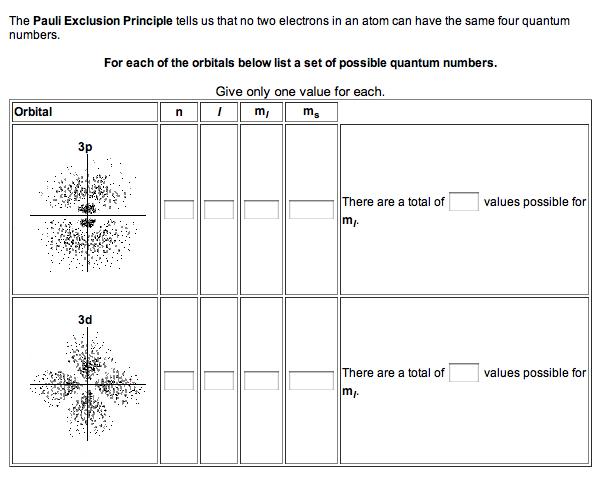
The table given below lists symbols traditionally used to denote shells and subshells. Each value of l thus corresponds to a subshell. Thus when shells fill, they start with l = 0, progress to l = 1, and so on. The probability clouds of electrons with the lowest value of l are closest to the nucleus and, thus, more tightly bound. Shells and the number of electrons in them determine the physical and chemical properties of atoms, since it is the outermost electrons that interact most with anything outside the atom. Each value of the principal quantum number n thus corresponds to an atomic shell into which a limited number of electrons can go. Higher values of the shell n correspond to higher energies, and they can allow more electrons because of the various combinations of l, m l, and m s that are possible.

As we progress up in the number of electrons, we go from hydrogen to helium, lithium, beryllium, boron, and so on, and we see that there are limits to the number of electrons for each value of n. This leads to the concept of shells and shell filling. Lithium (see the periodic table) has three electrons, and so one must be in the n = 2 level. (More precisely, their spin projections must differ.) Shells and Subshellsīecause of the Pauli exclusion principle, only hydrogen and helium can have all of their electrons in the n = 1 state. If there are two electrons in the n = 1 level, their spins must be in opposite directions. Since electrons cannot have the same set of quantum numbers, a maximum of two can be in the n = 1 level, and a third electron must reside in the higher-energy n = 2 level. The Pauli exclusion principle explains why some configurations of electrons are allowed while others are not. Figure 2 illustrates that there can be one or two electrons having n = 1, but not three.įigure 2. The spin projection m s can be either +1/2 or −1/2, and so there can be two electrons in the n = 1 state. The only value l can have is 0 (see Table 1 in Quantum Numbers and Rules for a list of possible values once n is known), and thus m l can only be 0.

So we first choose n, and then we see how many electrons can be in this energy state or energy level. Note that n determines the energy state in the absence of a magnetic field. Since no two electrons can have the same set of quantum numbers, there are limits to how many of them can be in the same energy state. For example, the quantum numbers (2, 1, 0, −1/2) completely specify the state of an electron in an atom. Since s is always 1/2 for electrons, it is redundant to list s, and so we omit it and specify the state of an electron by a set of four numbers ( n, l, m l, m s). The quantum numbers involved were defined in Quantum Numbers and Rules as n, l, m l, s, and m s. Let us examine how the exclusion principle applies to electrons in atoms. That is, no two electrons can be in the same state. No two electrons can have the same set of quantum numbers. It applies to any identical particles with half-integral intrinsic spin-that is, having s = 1/2, 3/2, … Thus no two electrons can have the same set of quantum numbers. The Pauli exclusion principle is extremely powerful and very broadly applicable. This statement is known as the Pauli exclusion principle, because it excludes electrons from being in the same state.

In 1925, the Austrian physicist Wolfgang Pauli (see Figure 1) proposed the following rule: No two electrons can have the same set of quantum numbers. We shall see in this section that the exclusion principle is key to the underlying explanations, and that it applies far beyond the realm of atomic physics. This systematic organization is related to the number of electrons in a neutral atom, called the atomic number, Z. The periodic table of the elements groups elements with similar properties into columns. The physical and chemical properties of elements are directly related to the number of electrons a neutral atom has. (credit: Nobel Foundation, via Wikimedia Commons)Īll atoms except hydrogen are multiple-electron atoms. He proposed the exclusion principle hypothesized the existence of an important particle, called the neutrino, before it was directly observed made fundamental contributions to several areas of theoretical physics and influenced many students who went on to do important work of their own. The Austrian physicist Wolfgang Pauli (1900–1958) played a major role in the development of quantum mechanics.


 0 kommentar(er)
0 kommentar(er)
